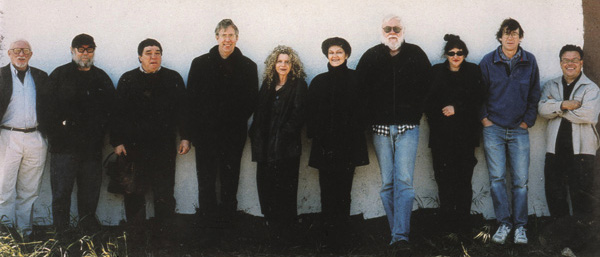Excellence and Pluralism
by Howard Singerman
This article originally appeared in Emergences: Journal for the Study of Media & Composite Cultures, Volume 12, Number 1, 2002.

UCLA Art Department Faculty, 1999. Pictured, from left: Henry Hopkins, Paul McCarthy, Chris Burden, James Welling, Barbara Kruger, Mary Kelley, John Baldessari, Nancy Rubins, Charles Ray, Lari Pittman. Photo: George Lange.
My university’s chief operating officer talks these days about the school’s ‘product lines.’ It is, he argues, a useful way to think about what the university does, because it now operates on the scale of the modern corporation and it has to answer to clients, constituents, and taxpayer shareholders. As a major state university, mine has five product lines: teaching, research, health care, service to the state and to businesses and organizations (teacher certification, for example, or consulting), and entertainment. This last category includes not only the university’s 19 different intercollegiate sports teams and their marketing paraphernalia, but also its concerts, theater productions, poetry readings, and art exhibitions. It’s not clear, though, that the university’s studio art department has caught up with the producer’s role, or whether the product it imagines is the same as our vice president’s. An undergraduate major housed alongside a graduate art history program, the studio here is devoted, at least on paper, in its departmental reviews and modest public relations, to the project of teaching art as a liberal art, in relation to language and history and the historical métiers of painting, sculpture, and printmaking. There is some small mention of community outreach, and little question, since it’s not a graduate program, of benchmarking or national ranking (or at least not until recently when it began to raise money and profile for a new building). Rather, the project of studio art at the University of Virginia has been something very much like Bildung or the old ideal of general education; its imaginary product is the well-rounded citizen and humanist.
The appeal to excellence marks the fact that there is no longer any idea of the University, or rather that the idea has now lost all content. As a non-referential unit of value entirely internal to the system, excellence marks nothing more than the moment of technology’s self-reflection. All the system requires is for activity to take place, and the empty notion of excellence refers to nothing other than the optimal input/output ratio in matters of information.2
…the opportunist’s sensitiveness seizes for the college certain elements [of art] which are convenient for public school education and in return for which certificates, fees, large enrollments, and some sense of progress may be available. The state universities and teachers’ colleges offer such preparation; someone living in town may have the technique, or a teacher in the department of home economics or music who has taken some art courses lacks a full schedule. Such background … produces practical work in basketry, china painting, stenciling, leather … [That] this is contrary to the theories of the college and makes relatively slow process [is] indicated by the status of the teachers: of 126 persons, eighty-seven are women, eighty-four have no college degree, and about sixty are instructors in rank.7
By 1959 crafts had disappeared entirely and the present program of majors in painting, sculpture, printmaking, and art history had superseded emphasis on teacher training… [By 1963] the faculty increased to 18, all but one a professional artist or art historian. In spring 1965 …the regents approved a new MFA program in studio subjects.24
Early in the academic planning, fine arts were separated from the humanities and established as a separate division including the departments of art, drama, music, and dance … The division departed from the usual university fine arts program by emphasizing professional commitment, studio and performance centered. The objectives are to provide a superior liberal education for the creative and performing artist, as well as studio and workshop experiences for the non-major. To carry out this commitment a faculty was recruited with high qualifications as professional performers and artists.25
To the extent that the quality of the faculty is to be judged from its reputation outside the university, the matter takes on a different light … Traditional scholarly departments, after all, are not exempt from this kind of criterion, based on the quality of journals and university presses that sponsor their publications and of the critical reception their books encounter … the criterion established by important gallery and museum exhibitions (one-man or group) cannot be entirely dismissed; and by this criterion the UCLA ladder faculty is not comparable to, say, that of Irvine or Davis.27
We set out to identify great work being created in Los Angeles by graduates and current students of Los Angeles-area art colleges. No one had paid sufficient homage to the role Southern California art schools had played in the growth of Los Angeles into an international art center. So we resolved to use CAA’s [Creative Artists Agency’s] headquarters in Beverly Hills to showcase a collection of work by emerging artists and teachers associated with those schools … These scholarships will commence for the upcoming 2000–2001 school year at the University of California at Los Angeles, Art Center College of Design, California Institute of the Arts, the University of California at Irvine and Otis College of Art and Design.